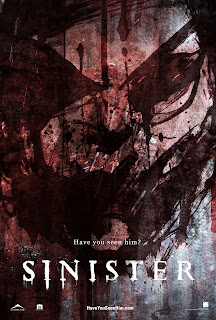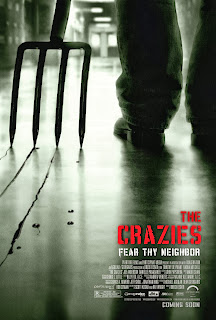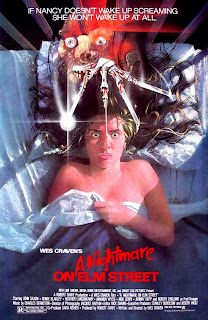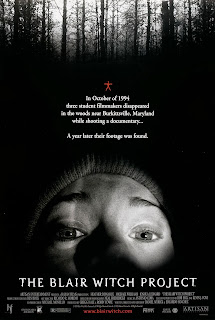31 films in total.
7 of these films were re-watches.
 In a bid to try and retain some level of originality in my film choices for this series I have decided not to talk about Halloween today, despite the fact that it has probably the most iconic, brilliant and memorable soundtrack of any horror film. This decision meant that I spent a good deal of time racking my brain for another film that has an impressive soundtrack, and then I remembered Sinister.
In a bid to try and retain some level of originality in my film choices for this series I have decided not to talk about Halloween today, despite the fact that it has probably the most iconic, brilliant and memorable soundtrack of any horror film. This decision meant that I spent a good deal of time racking my brain for another film that has an impressive soundtrack, and then I remembered Sinister. There were no other choices for this post.
There were no other choices for this post. Creepy children have been a staple of horror films for decades, whether they be ghosts, the undead or the subject of demonic possession. This is a sure development of cultural fears of children and the heightened awareness of the supernatural that they are perceived as having, a fear that the invisible friend that they claim to have could indeed be real. In spite of the influx of terrifying, monstrous children that provide countless choices for this post I have chosen a child that is very much alive, Danny from The Shining.
Creepy children have been a staple of horror films for decades, whether they be ghosts, the undead or the subject of demonic possession. This is a sure development of cultural fears of children and the heightened awareness of the supernatural that they are perceived as having, a fear that the invisible friend that they claim to have could indeed be real. In spite of the influx of terrifying, monstrous children that provide countless choices for this post I have chosen a child that is very much alive, Danny from The Shining. As I discussed in my post for day 2 of this challenge, remakes are almost always a troublesome beast. They are very rarely warranted and often disappoint. There are only a handful of horror remakes that have been any good, and even less that have surpassed their original in any way. I recently watched George A. Romero's 1973 film The Crazies and after seeing the original I can now say that I believe the 2010 remake has gained a spot in that elite group of superior remakes.
As I discussed in my post for day 2 of this challenge, remakes are almost always a troublesome beast. They are very rarely warranted and often disappoint. There are only a handful of horror remakes that have been any good, and even less that have surpassed their original in any way. I recently watched George A. Romero's 1973 film The Crazies and after seeing the original I can now say that I believe the 2010 remake has gained a spot in that elite group of superior remakes. My job caught up with me this last weekend and so today will become a blogging marathon, with four posts to back date.
My job caught up with me this last weekend and so today will become a blogging marathon, with four posts to back date. Day 18, and once again I have chosen a film that is not actually a horror film, but one which uses an aspect of the cinematic medium in a way that is evocative of the genre.
Day 18, and once again I have chosen a film that is not actually a horror film, but one which uses an aspect of the cinematic medium in a way that is evocative of the genre. I'm not the biggest fan of one-liners in horror films as I think they are a sure-fire way to kill any atmosphere that has been built thus far. I grew up on the Nightmare on Elm Street franchise but, as much as Freddy Krueger has been a favourite of mine since then, I do find the decent into comedy that the character and franchise took too severe. From the get-go Freddy had a dark sense of humour and Robert Englund certainly played that up, but the latter films simply became a cocktail of farce and gore, which I no longer enjoy.
I'm not the biggest fan of one-liners in horror films as I think they are a sure-fire way to kill any atmosphere that has been built thus far. I grew up on the Nightmare on Elm Street franchise but, as much as Freddy Krueger has been a favourite of mine since then, I do find the decent into comedy that the character and franchise took too severe. From the get-go Freddy had a dark sense of humour and Robert Englund certainly played that up, but the latter films simply became a cocktail of farce and gore, which I no longer enjoy. Dumbo is probably one the the last films I think anyone would expect to see making an appearance on a Horror-themed list, but here it is. For anyone unfamiliar with Dumbo this scene takes place after the titular elephant and his friend Timothy Q. Mouse stumble upon some alcohol. They both get pretty stinking drunk and Dumbo begins blowing bubbles out of his trunk, one of witch transforms itself into the shape of an elephant. A hallucinatory sequence proceeds in which countless elephants perform and dance to the song 'Pink Elephants On Parade".
Dumbo is probably one the the last films I think anyone would expect to see making an appearance on a Horror-themed list, but here it is. For anyone unfamiliar with Dumbo this scene takes place after the titular elephant and his friend Timothy Q. Mouse stumble upon some alcohol. They both get pretty stinking drunk and Dumbo begins blowing bubbles out of his trunk, one of witch transforms itself into the shape of an elephant. A hallucinatory sequence proceeds in which countless elephants perform and dance to the song 'Pink Elephants On Parade". I only watched Alien for the first time yesterday, and it is probably because it is so fresh in my mind that it seemed the perfect choice for today's post.
I only watched Alien for the first time yesterday, and it is probably because it is so fresh in my mind that it seemed the perfect choice for today's post. Like so many of the other posts in this series today's topic could have been based around any number of films, because many of the sub-genres within horror require a well-crafted antagonist in order to be successful. The chain of 80s slashers in particular were the breeding ground for murderous villains that have each become iconic in their own right, spawning long lasting franchises. Today I want to talk about one of the lesser recognised of these heavy-hitters, the Cenobites of the Hellraiser series.
Like so many of the other posts in this series today's topic could have been based around any number of films, because many of the sub-genres within horror require a well-crafted antagonist in order to be successful. The chain of 80s slashers in particular were the breeding ground for murderous villains that have each become iconic in their own right, spawning long lasting franchises. Today I want to talk about one of the lesser recognised of these heavy-hitters, the Cenobites of the Hellraiser series. Todays post is not about a horror film, at least not in the typical sense; The Night of the Hunter is a 1955 thriller but one which features themes and stylistic techniques that are evocative of those found in horror.
Todays post is not about a horror film, at least not in the typical sense; The Night of the Hunter is a 1955 thriller but one which features themes and stylistic techniques that are evocative of those found in horror.  Sequels are a tricky business because they are immediately met with high expectations and as a result have a history of being disappointing. I'm not convinced that I have ever come across a bad original/great sequel pairing within the horror genre, so I have settled on a terrible original/good sequel pairing instead.
Sequels are a tricky business because they are immediately met with high expectations and as a result have a history of being disappointing. I'm not convinced that I have ever come across a bad original/great sequel pairing within the horror genre, so I have settled on a terrible original/good sequel pairing instead. I had quite the list of options for today's post. Many directors have found masterful ways to make completely mundane objects a source of terror. I considered talking about Chucky the killer doll, the videotape from Ringu, the ventriloquist dummy from Dead Silence or any child's toy from any horror film ever. Finally I settled on a prop that in some way features in the majority of horror films; the phone.
I had quite the list of options for today's post. Many directors have found masterful ways to make completely mundane objects a source of terror. I considered talking about Chucky the killer doll, the videotape from Ringu, the ventriloquist dummy from Dead Silence or any child's toy from any horror film ever. Finally I settled on a prop that in some way features in the majority of horror films; the phone. It's worrying that we now live in a time where there is a sub-genre of horror that is called 'torture-porn', where if a film doesn't show extreme bodily mutilation it is considered tame. The number of films that could meet the criteria of 'incredibly twisted' is a lot longer than it really should be, and so in choosing a film for today it had to be something really disturbing.
It's worrying that we now live in a time where there is a sub-genre of horror that is called 'torture-porn', where if a film doesn't show extreme bodily mutilation it is considered tame. The number of films that could meet the criteria of 'incredibly twisted' is a lot longer than it really should be, and so in choosing a film for today it had to be something really disturbing. Alfred Hitchcock is responsible for perhaps one of, if not the, most iconic and recognisable sound effects ever used in a horror film; a repetitive high-pitched screeching which pierces the viewers ears as Norman Bates repeatedly stabs Marion Crane to death in Psycho.
Alfred Hitchcock is responsible for perhaps one of, if not the, most iconic and recognisable sound effects ever used in a horror film; a repetitive high-pitched screeching which pierces the viewers ears as Norman Bates repeatedly stabs Marion Crane to death in Psycho.  As one of the most widely recognized first examples of the 'found footage' sub-genre this film gets a lot of stick from viewers as not being scary enough, or even as good as everyone says it is. To categorise, the people of this opinion seem to share the notion that obvious jump scares are horror and a film cannot be frightening unless things are jumping out from the dark every few minutes. While this works in many films The Blair Witch Project is an example of a more subdued and disturbing horror. Not a single question is answered by the end of the film, and no Blair Witch has been seen on film. I'm sad to see that many people equate these factors to the film being bad.
As one of the most widely recognized first examples of the 'found footage' sub-genre this film gets a lot of stick from viewers as not being scary enough, or even as good as everyone says it is. To categorise, the people of this opinion seem to share the notion that obvious jump scares are horror and a film cannot be frightening unless things are jumping out from the dark every few minutes. While this works in many films The Blair Witch Project is an example of a more subdued and disturbing horror. Not a single question is answered by the end of the film, and no Blair Witch has been seen on film. I'm sad to see that many people equate these factors to the film being bad. While there is certainly an argument for any remake being unnecessary in the spirit of this series I'll refrain from any repetitive rants about the lack of originality in Hollywood today. Instead I have chosen a remake that fits into both criteria of disappointing AND unnecessary, 2009's The Uninvited.
While there is certainly an argument for any remake being unnecessary in the spirit of this series I'll refrain from any repetitive rants about the lack of originality in Hollywood today. Instead I have chosen a remake that fits into both criteria of disappointing AND unnecessary, 2009's The Uninvited. As the first in my October Horror series this was pretty straight-forward to come up with, as it's not very often that the horror films I see at the cinema are all that scary. I was fairly certain that Insidious would be no different, despite all of the reviews telling me otherwise. I think that horror, like comedy, is one of the hardest genres to convincingly and objectively review, simply because the success of the film lies in each viewers subjective reaction to it.
As the first in my October Horror series this was pretty straight-forward to come up with, as it's not very often that the horror films I see at the cinema are all that scary. I was fairly certain that Insidious would be no different, despite all of the reviews telling me otherwise. I think that horror, like comedy, is one of the hardest genres to convincingly and objectively review, simply because the success of the film lies in each viewers subjective reaction to it.